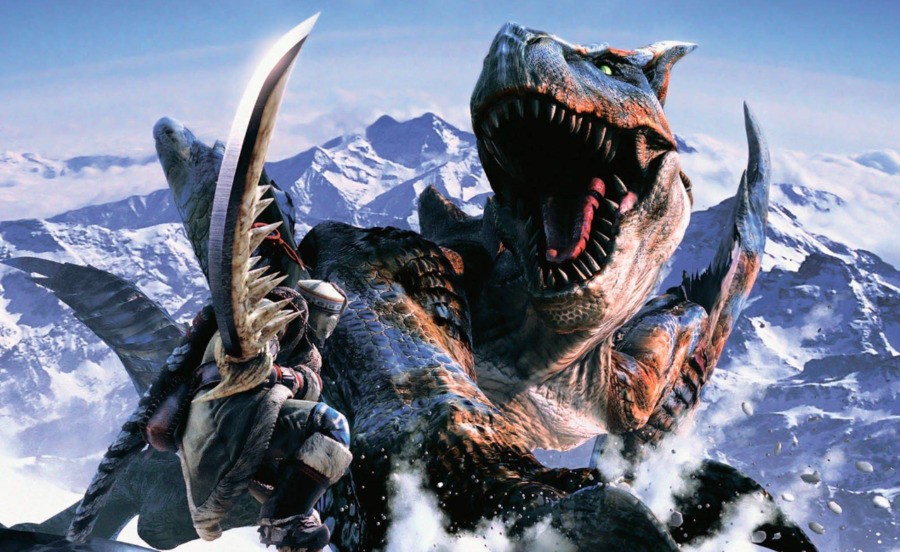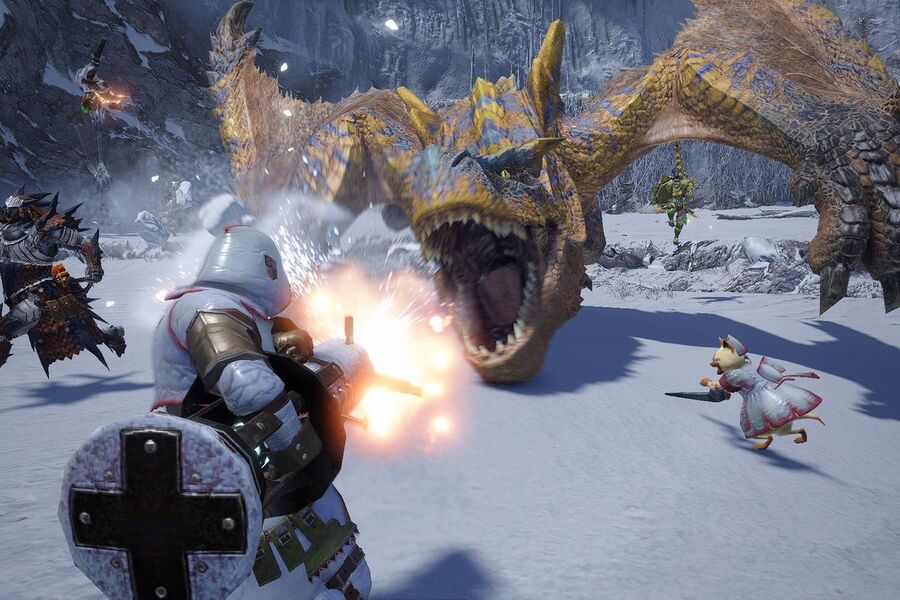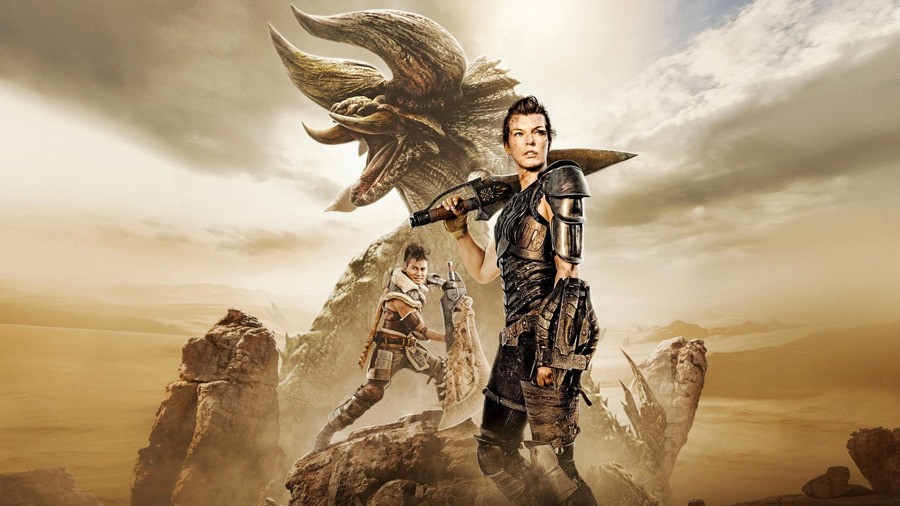Monster Hunter is Capcom’s second-best-selling video game franchise. It’s bigger than Street Fighter, it’s bigger than Devil May Cry, and it’s bigger than Mega Man. However, it could be argued that Monster Hunter has had a rocky road leading up to the monumental success of Monster Hunter: World in 2017 – at least in terms of global recognition, anyway.
So, how did the series manage to reach the heights that it enjoys now? It all begins with the advent of online console gaming. When Sony released the PlayStation 2 Network adapter in 2004, Capcom set out to develop online games to support this brand-new infrastructure; one of the fruits borne out of this initial effort was Monster Hunter, a third-person action game where you can team up with your friends to take down gigantic monsters. Inspired by games like Sega’s seminal Phantasy Star Online, Monster Hunter established its trademark gameplay loop early. Gather, Craft, Hunt, Repeat.
However, upon its release, Monster Hunter released to lukewarm reviews, with GameSpot infamously calling it “a living fossil”. Suffice to say, it wasn’t exactly a runaway hit. Nevertheless, Capcom went ahead to develop Monster Hunter G, adding in new subspecies of Monster, leading to more armour sets and most notably, more weapons. Monster Hunter G never got a Western Release, but its expansion, Monster Hunter Freedom for the PSP, did.
Monster Hunter found a dedicated audience on the PSP in the Far East, with its co-op collaborative play becoming incredibly popular in a market that was (and still is) utterly smitten with portable games consoles. It was here that Capcom started work on the second generation of Monster Hunter. Monster Hunter 2 debuted in 2006 on the PlayStation 2 as a Japan-Only release, adding key features such as upgradeable armour, ‘Gem Skills’ and the addition of now-iconic weapons like the Long Sword, Gunlance, Horn and Bow. However, it was at this point that the series began its shift from domestic consoles to handhelds – a shift that would arguably turn it into the behemoth we know today.
With Monster Hunter hitting fever pitch in Japan, another PSP expansion was ordered, and Monster Hunter Freedom 2 was released worldwide in 2007. This game kickstarted the cult status of Monster Hunter in the West, with many having their first experience of the franchise with Monster Hunter Freedom 2. A year later, we saw the release of Monster Hunter Freedom Unite, which added an endgame G-Rank for experienced players, along with a host of new monsters – and, for the first time, downloadable quests. Monster Hunter Freedom Unite went on to sell 3.8 million copies worldwide.
With the next generation of home consoles in full-swing, Capcom’s beast-busting franchise found itself in a strange spot; poor sales of Monster Hunter Frontier combined with the issue of Japanese developers struggling to wrestle with the PlayStation 3’s confusing hardware architecture meant that the next generation of Monster Hunter was set to release on red-hot Nintendo Wii; not the most technically-advanced system on the market, but certainly the best-selling. This time, both Capcom and Nintendo were eager to push this as a ‘hardcore’ Wii release, which meant a rather curious marketing campaign over here in the West.
With a bundle that came along with a Wii Classic Controller and Wii Speak (Voice chat! On a Nintendo console! Imagine that!), 2010’s Monster Hunter Tri wanted to make a splash with brand-new underwater hunts, some new weapons, and a new variety of areas to explore. Curiously, while online play was free in Europe and America, the Japanese release of Monster Hunter Tri required a monthly fee to hunt online. “Monster Hunter Tri is slow out of the gate,” we said in our review of the game. “Even experienced hunters take ten or fifteen hours to understand its new features and learn the monsters’ behaviours. Playing with a team of fellow hunters is some of the most fun you’ll have online with any console, although solo play is enjoyable too. If you have the dedication to get through the hard-going introduction, you’ll uncover an addictive, innovative and beautiful game of ever-increasing depth.” While Tri managed to find a smaller, niche audience in the West, it still lingered in obscurity, as its expansion, Monster Hunter Portable 3rd, was Japan-only just a year later.The series continued to have widespread success, and Monster Hunter 3G was released for 3DS in 2011, with a fully-online Wii U and 3DS release coming two years later in early 2013. Released in the West as Monster Hunter 3 Ultimate, this entry had a host of tricks up its sleeve to smooth out some of the edges that gamers were getting stuck on. With the introduction of the Target Camera, gamers were no longer having to ‘claw’ their way around the maps on the portable versions of the game, and the 3DS and Wii U had a save-transfer service where you could pick up your character from each version and take it with you on the go. New monsters and areas were added, in addition to weapons that were not featured in the original release of Tri. “Monster Hunter 3 Ultimate is the perfect name choice, as this takes the already exceptional Wii title and adds a daunting amount of new content and a HD sheen,” we said in our review. “Those that missed Monster Hunter Tri but like the concept should pick this up without delay, and those that enjoyed the original should also do the same — the quest is practically never-ending, and that’s absolutely fine by us.”
Monster Hunter 3 Ultimate started to generate some genuine hunger for Monster Hunter in the West; the Wii U’s online services and built-in mic made for online play extremely smooth and didn’t require gamers to rely on local-play to team up with their friends, unlike its portable brethren. With more quests, subspecies and added depth through modification of armour via the use of gems, the customisation aspect of Monster Hunter grew even deeper, iterating and evolving with every release.
With the successes of Monster Hunter on Wii, 3DS and Wii U, Nintendo was eager to grab a bigger slice of the portable pie to boost its 3DS software lineup. It was around this time that rumours swirled that the next mainline Monster Hunter game would not be coming to Sony’s PlayStation Vita, with Capcom signing an exclusivity deal with Nintendo that would last for three years. While never officially confirmed, this rumour would now appear to hold weight – between 2013 and 2017, Monster Hunter was entirely absent from Sony systems.
Monster Hunter 4 Released in late 2013 as a Japanese exclusive for the 3DS, boasting more verticality in its environments and gameplay, alongside a bigger focus on story content for the single-player campaign and full online functionality. An expansion would arrive in late 2014 in Japan and early 2015 in Europe; Monster Hunter 4 Ultimate released alongside the ‘New’ Nintendo 3DS, with full support for the console’s second analogue ‘nub’. It also added more monsters and a G-Rank mode. Critics were all over it, with Monster Hunter 4 Ultimate garnering a respectable Metacritic score of 86, as well as being the best-selling title in the series outside of Japan at the time of release. “If you’re a Monster Hunter fan the answer is simple, buy this game,” is what we said when we reviewed it at launch. “It’s a significant undertaking but utterly enthralling once you’re drawn in. There’s a greater sense of story to make the single-player exploits a little more interesting than is typical, and online is slick and performs well New weapons, locations and monsters make this a treat for fans, if still intimidating to those considering a first dip; yet if you’re up for the investment in time, this is another special experience from Capcom. A true portable blockbuster.”
With Monster Hunter 4’s formula established, Capcom decided to put work into developing each weapon’s move-set and style, adding flashy finishing moves and equippable arts into their next release. In late 2015 Monster Hunter Generations made its debut in Japan under the title Monster Hunter X (Cross), and with fans clamouring for a Western release, it was finally localised for the west in 2016. With a whopping 72 different Hunting Styles and packed with locations, maps and assets from the series’ rich history, it sported 93 unique monsters and is often viewed as a ‘Greatest Hits’ of the series up to this point – before the biggest revolution in Monster Hunter’s 14-year history. “Monster Hunter Generations, overall, is the match of its predecessors that also boasts some innovations and improvements,” read our review. “This franchise is yet to reach near-perfection, but it’s still one of the most enjoyable and immersive time-sinks to be found on Nintendo hardware. For any gamer ready for a long-term challenge, with tough battles and plenty of complexity to master, this is most certainly worth hunting down.”
Around this time, Capcom made an attempt to broaden the appeal of the series with spin-off Monster Hunter Stories, which adopted a more traditional JRPG approach and would eventually find its way to the west in 2017, following its initial Japanese launch a year earlier. Despite the change of approach, the game found the mark with us. “Monster Hunter Stories is an excellent adventure that channels the colourful world of Capcom’s storied series into a joyous JRPG. Longtime MonHun fans will appreciate Stories as a thoughtfully-made spin-off, but the gameplay template and tone are so different that you don’t need to be familiar with – or even enjoy! – mainline Monster Hunter to have a great time here.”
With Nintendo’s period of exclusivity coming to a close, Capcom seemed keen to take Monster Hunter to the next level. While the series had enjoyed incredible success on Nintendo hardware, it was clear that by ignoring Sony and Microsoft’s systems, Capcom was missing out on a big slice of potential revenue. A next-generation entry was needed. Monster Hunter: World made use of the horsepower of the PlayStation 4 and Xbox One, being revealed at E3 in 2017. Its distinct change in colour palette, focus on hand-holding and various ‘quality of life’ changes to the core gameplay loop made longtime fans sceptical at first; however, thanks to the removal of loading screens in large areas and drastically improved visuals, Monster Hunter: World hit the mark – it has enjoyed sales of over 10 million copies worldwide and has become Capcom’s best selling game ever. “Monster Hunter: World is easily the finest entry in the franchise to date,” said our friends over at Push Square. “The move to PS4 has only done it favours, with stunning visuals and environments that you’ll want to get lost in. Flashy, satisfying combat will lead to many water-cooler chats, and vastly improved online features make it a breeze to find help.” Capcom followed up with the expansion Monster Hunter World: Iceborne in 2019, which sold an impressive 7.2 million copies. “Iceborne is a truly monstrous expansion,” Push Square commented. “Capcom has gone above and beyond in crafting an additional adventure that breathes a shocking amount of new life into Monster Hunter World, setting a new benchmark for the series in terms of pure quality. Iceborne is Monster Hunter at its absolute best.”
However, the story doesn’t end there. In 2017, Monster Hunter Generations spawned a further 3DS expansion in Japan – Monster Hunter XX – which remained exclusive to the region. Japanese players would benefit from an upgraded version of this title for the newly-launched Nintendo Switch in August 2017; this was released in the west under the title Monster Hunter Generations Ultimate. “Monster Hunter Generations Ultimate may lack the smoothness and accessibility that made Monster Hunter: World such a smash hit, but it more than makes up for it by being a sort of ‘greatest hits’ collection of the high points of the series, giving you hundreds of hours of content to play through,” is what we said in our review. “It may not necessarily represent the future of the series, but Monster Hunter Generations Ultimate is an utterly fantastic experience in its own right and a worthy follow up to the 3DS original, and one that no Switch owner will want to be without.”
With Monster Hunter: World and Monster Hunter Generations Ultimate releasing so close to one another, it seemed that the future of the series was to be decided by the performance of each “style”. The massive commercial success of World might have led you to believe that Capcom would follow that template moving forward, but the announcement of Monster Hunter Rise for the Nintendo Switch in 2020 put paid to that notion; Capcom wasn’t about to abandon the massive portable fanbase it has in its native Japan – the same fanbase which propelled the series to megastardom during the PSP and 3DS eras.
Monster Hunter Rise isn’t a lazy retread of previous handheld efforts, though; it brings a lot of innovation to the table. Launching alongside Rise in 2021 is Monster Hunter Stories 2: Wings of Ruin, a fresh attempt by Capcom to build-up and expand the franchise in a JRPG direction. Speaking of which, the close of 2020 saw the release of Hollywood’s Monster Hunter live-action movie, directed by Paul W. S. Anderson and starring Milla Jovovich, Tony Jaa and Ron Perlman, the film initially caused upset by tinkering with the story; Jovovich is a modern-day soldier sent to a fantasy realm. However, more drama would ensue when the movie was launched in China, one of its key markets. In a scene involving Asian-American actor Jin Au-Yeung, a racial slur was used which resulted in the movie being pulled from Chinese cinemas and its premiere cancelled. Both the director and the actor apologised, but ultimately Monster Hunter flopped at the Box Office – although we’d argue that this was equally down to the fact that it was released during a global pandemic.
Still, ropey movie adaptations aside, Monster Hunter has arguably never been more popular, and with Rise and Stories 2 arriving in 2021, the future is bright for Capcom’s beast-busting epic.





Be the first to comment